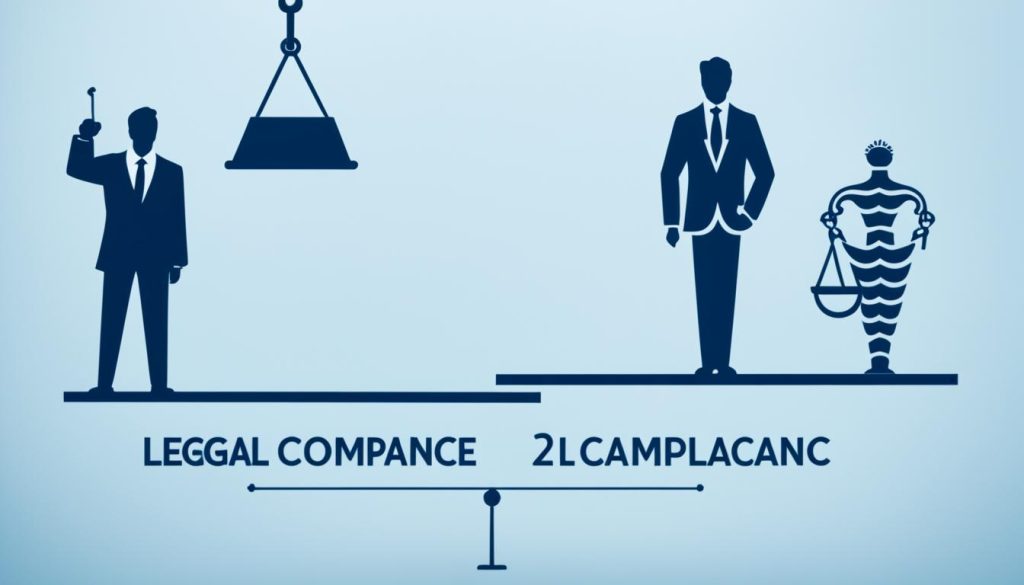Welcome to our comprehensive hiring guide, where we will walk you through the process of employing someone for your business. Hiring the right staff is crucial for the success of any organization, as it directly impacts productivity, efficiency, and overall growth. In this guide, we will provide you with the necessary steps, guidelines, and best practices to effectively navigate the recruitment process and ensure a successful integration of new employees into your team.
Whether you’re a small startup or an established company, the recruitment process can be time-consuming and complex. With so many aspects to consider, from employee onboarding to recruitment checklists and employment procedures, it’s essential to have a clear understanding of each stage to streamline the process and make the right hiring decisions.
Throughout this guide, we will cover various topics, including assessing business readiness to employ staff, understanding legal considerations, developing an efficient recruitment strategy, ensuring legal compliance during the hiring process, structuring a competitive compensation package, finalizing contractual agreements and documentation, fulfilling tax obligations, and setting up payroll systems.
Whether you’re new to hiring or looking to refine your procedures, this guide will provide the necessary guidance to enhance your hiring practices and attract top talent to your organization. So, let’s dive in and discover how to employ someone for your business.
Preparing Your Business for New Employees
Assessing Business Readiness to Employ Staff
Before embarking on the hiring process, it is essential to assess your business’s readiness to employ staff. Consider the following factors:
- Finances: Evaluate your financial stability and ensure that you have adequate resources to cover new hires’ salaries, benefits, and other employment costs.
- Operational Capacity: Determine whether your business has the infrastructure and capacity to support additional employees. This includes assessing your workspace, equipment, and technology.
- Workload Analysis: Conduct a comprehensive analysis of your current workload and workload distribution. Identify areas where additional assistance is needed and define the roles and responsibilities of the new hires to fill those gaps effectively.
- Training and Onboarding: Consider your business’s ability to provide necessary training and onboarding for new employees. Develop a plan to ensure seamless integration into your company culture and efficient knowledge transfer.
Legal Considerations Before Hiring
Before hiring new employees, it is crucial to be aware of the legal considerations to protect your business and ensure compliance with employment laws. Pay attention to the following aspects:
- Employment Contracts: Familiarize yourself with the laws and regulations surrounding employment contracts and ensure that you draft clear and legally binding agreements.
- Discrimination Laws: Understand the anti-discrimination laws in place to protect employees against unfair treatment based on factors such as age, race, gender, disability, or religion.
- Right-to-Work Checks: Verify the employment eligibility of potential employees by conducting right-to-work checks and complying with all relevant immigration and border control requirements.
- Data Protection: Ensure that you handle personal data in accordance with data protection laws, such as the General Data Protection Regulation (GDPR), to safeguard employee information.
Understanding Employer Responsibilities
As an employer, you have certain responsibilities and obligations towards your employees. These include:
- Providing a Safe and Healthy Work Environment: Take appropriate measures to ensure the physical and mental well-being of your employees, providing a safe and hazard-free workplace.
- Complying with Employment Laws: Stay up to date with the applicable employment laws and regulations, including those related to working hours, minimum wage, and employee rights.
- Duty of Care: Exercise a duty of care towards your employees, taking reasonable steps to protect them from harm or injury.
- Equal Opportunities: Promote diversity, inclusivity, and equal opportunities within your workplace, addressing any forms of discrimination and fostering a fair and respectful environment for all employees.
By preparing your business for new employees and understanding the legal considerations and employer responsibilities, you can create a solid foundation for a successful and compliant hiring process.
Developing an Efficient Recruitment Strategy
Developing an efficient recruitment strategy is crucial for finding and hiring the right candidates for your business. A well-executed recruitment strategy not only streamlines the hiring process but also ensures that you attract talented individuals who align with your company’s values and goals. In this section, we will explore the key steps involved in creating an effective recruitment strategy, from defining job requirements to utilizing recruitment agencies.
Defining Job Requirements
One of the first steps in developing your recruitment strategy is clearly defining the job requirements for the position you are looking to fill. This involves identifying the skills, experience, and qualifications necessary for success in the role. By clearly outlining your expectations, you can attract candidates who have the specific attributes you are seeking.
Creating Job Advertisements
Once you have defined the job requirements, the next step is to create compelling job advertisements that will attract qualified candidates. Your job advertisements should provide a clear and concise description of the role, its responsibilities, and the benefits of working for your company. Utilize keywords and phrases that are relevant to the position and industry to optimize visibility in online job boards and search engines.

Conducting Interviews
Interviews are a vital part of the candidate selection process. They give you the opportunity to assess a candidate’s qualifications, skills, and fit within your company culture. When conducting interviews, be sure to prepare well-crafted interview questions that are tailored to the specific job requirements. This will allow you to gain valuable insights into a candidate’s abilities and suitability for the role.
Utilizing Recruitment Agencies
Recruitment agencies can be valuable partners in your recruitment strategy. They have access to a wide network of candidates and can help you identify qualified individuals who may not be actively searching for a job. Additionally, recruitment agencies can assist with screening and shortlisting candidates, saving you time and effort in the hiring process. Collaborating with a reputable recruitment agency can significantly enhance your chances of finding the best talent for your organization.
By implementing these steps in your recruitment strategy, you can optimize your hiring process and increase your chances of finding the right candidates for your business. Remember, developing an efficient recruitment strategy is an ongoing process that requires continuous evaluation and refinement to adapt to changing market conditions and hiring needs.
Ensuring Legal Compliance in Your Recruitment Process
Navigating Right to Work and DBS Checks
When it comes to recruiting new employees, ensuring legal compliance is of utmost importance. Conducting right to work checks and DBS checks can help safeguard your business and ensure that you are making informed hiring decisions.
Right to work checks verify an individual’s eligibility to work in the UK. This involves checking and verifying documents that prove their right to work in the country. It is crucial for employers to carry out these checks for every employee to prevent employing individuals who are not entitled to work in the UK. Employers can find detailed guidance on the official government website, including the list of acceptable documents for right to work checks hee.
DBS checks, also known as Disclosure and Barring Service checks, are an essential part of the recruitment process, especially when hiring for positions that involve working with vulnerable groups such as children or adults at risk. These checks help employers make informed decisions by providing information about an individual’s criminal record, if any. Employers can submit requests for DBS checks through the official DBS website here.
Fair and Accessible Hiring Practices to Avoid Discrimination
Employers must adopt fair and accessible hiring practices to create a diverse and inclusive workforce and to prevent discrimination in the recruitment process. Implementing such practices is not only the right thing to do but also helps attract and retain top talent, leading to a more productive and successful business.
Here are some guidelines to promote fair and accessible hiring practices:
- Create inclusive job advertisements that focus on essential qualifications and skills rather than non-essential characteristics. Avoid language that may discourage underrepresented groups from applying.
- Conduct unbiased interviews by using standardized interview questions and evaluation criteria for all candidates. Avoid asking questions that could be discriminatory.
- Promote diversity and equal opportunities by actively seeking candidates from different backgrounds and considering a variety of perspectives during the selection process.
By following these guidelines, employers can create a fair and inclusive recruitment process that upholds the principles of equal opportunities and discrimination prevention.

| Importance of Legal Compliance in Recruitment | Benefits of Fair Hiring Practices |
|---|---|
| Ensures adherence to employment laws and regulations. | Attracts a diverse pool of qualified candidates. |
| Mitigates the risk of legal disputes and financial penalties. | Fosters a positive company culture and reputation. |
| Protects the rights of workers and promotes a safe working environment. | Enhances innovation and creativity through different perspectives. |
Structuring a Competitive Compensation Package
When it comes to attracting and retaining top talent, a competitive compensation package is crucial. Offering a comprehensive and appealing compensation package can significantly enhance your ability to attract qualified candidates and keep your employees satisfied.
One important aspect of structuring a compensation package is determining appropriate salary ranges for different positions within your organization. Conducting market research and benchmarking salaries within your industry can help ensure that your offers are competitive and align with industry standards. This will enable you to negotiate salaries effectively during the hiring process, increasing the likelihood of attracting top candidates.
In addition to salary negotiation, employee benefits play a significant role in shaping a competitive compensation package. Offering attractive benefits such as healthcare coverage, retirement plans, paid time off, and professional development opportunities can make your organization more appealing to job seekers. Benefits not only improve employee satisfaction, but also promote employee well-being and loyalty, contributing to a positive work environment.

When structuring your compensation package, it’s essential to consider the specific needs and preferences of your workforce. Conducting surveys or engaging in open discussions with employees can help you identify the benefits that matter most to them. This employee-centric approach can guide you in tailoring your compensation package to meet the diverse needs of your team.
Remember that a competitive compensation package goes beyond just salary and benefits. It should also include other forms of compensation such as bonuses, incentives, and recognition programs that reward outstanding performance. These elements can motivate employees, boost morale, and foster a culture of excellence within your organization.
In conclusion, structuring a competitive compensation package is vital for attracting and retaining top talent. By offering appropriate salary ranges, negotiating salaries effectively, and providing attractive employee benefits, you can position your organization as an employer of choice in the competitive job market.
Finalizing Contractual Agreements and Documentation
Once you have identified the ideal candidate for your business, it’s crucial to finalize the necessary contractual agreements and documentation to formalize their employment. This ensures clarity and protection for both parties involved. In this section, we will explore two key aspects of this process: establishing the terms of employment and drafting a clear job description and statement of employment.
Establishing Terms of Employment
The terms of employment encompass various aspects that define the working relationship between the employer and the employee. It is important to establish these terms to avoid any misunderstandings or conflicts in the future. The key elements of terms of employment include:
- Job responsibilities: Clearly define the roles and responsibilities that the employee will undertake in their position. This provides clarity and sets expectations for both parties.
- Working hours: Outline the expected working hours, including any specific shift patterns or flexibility requirements.
- Remuneration: Specify the salary or hourly rate, as well as any additional benefits, such as bonuses, commissions, or employee perks.
- Leave entitlement: Detail the employee’s entitlement to annual leave, public holidays, sick leave, and any other forms of paid or unpaid leave.
- Notice period: Outline the notice period required by both the employer and the employee in the event of termination or resignation.
- Probation period: If applicable, define the duration and conditions of the probationary period, during which performance and suitability for the role will be assessed.
- Confidentiality and non-disclosure agreements: Include any necessary clauses to protect sensitive company information and intellectual property.
Drafting a Clear Job Description and Statement of Employment
A clear and comprehensive job description is essential for setting the expectations and requirements of a role. It helps both the employer and the employee understand the nature of the job and the skills, qualifications, and experience needed to fulfill it. When drafting a job description, consider the following:
- Job title: Provide an accurate and descriptive job title that reflects the role’s responsibilities.
- Job summary: Summarize the main purpose and objectives of the role in a concise and engaging manner.
- Key responsibilities: List the main tasks and duties the employee will be expected to perform.
- Qualifications and experience: Specify the qualifications, certifications, skills, and experience required to excel in the role.
- Reporting structure: Indicate the position’s place within the company’s hierarchy and any team or managerial responsibilities.
- Working conditions: Highlight any physical or environmental conditions that may be relevant to the role.
By establishing the terms of employment and providing a clear job description, you can ensure a smooth onboarding process for your new employee and set the stage for a successful working relationship.

Fulfilling Tax Obligations and Setting Up Payroll
When employing staff, it is essential for employers to fulfill their tax obligations and set up a reliable payroll system to ensure smooth operations. This section will guide you through the necessary steps to register with HMRC and understand the PAYE (Pay As You Earn) deductions, as well as provide insights on implementing an efficient payroll system.
Registering with HMRC and Understanding PAYE
Prior to hiring employees, it is crucial to register with HMRC (Her Majesty’s Revenue and Customs) to fulfill your tax and national insurance obligations. Registering with HMRC will enable you to deduct the appropriate amount of PAYE from employee salaries and make tax and national insurance contributions.
By understanding the PAYE system, you can ensure that accurate deductions are made from employee wages. PAYE deductions include income tax, National Insurance contributions, and any student loan repayments. It is important to stay up-to-date with the latest payroll regulations and ensure compliance to avoid any penalties or legal issues.
To register with HMRC and set up PAYE, you will need to provide relevant details about your business, including your business name, address, contact information, and UTR (Unique Taxpayer Reference) if applicable. Consult with an accountant or HMRC guidance for specific requirements based on your business structure and circumstances.
Implementing a Reliable Payroll System
An efficient payroll system is essential for accurately processing employee wages and ensuring timely payments. Implementing a reliable payroll system can help streamline payroll processes, avoid errors, and maintain compliance with payroll regulations.
When choosing a payroll system, consider your business size, complexity, and budget. There are various options available, including cloud-based payroll software and outsourced payroll services. Look for a system that can handle employee records, calculate deductions, generate payslips, and provide reports for tax purposes.
Setting up your payroll processes involves inputting employee information, such as names, addresses, tax codes, and salary details, into the payroll system. You will need to establish regular payroll cycles, determine payment methods (e.g., direct deposit or physical checks), and ensure compliance with wage laws, including minimum wage requirements and holiday pay entitlements.
Complying with payroll regulations involves maintaining accurate records, submitting real-time information (RTI) to HMRC, and staying informed about changes in tax codes and legislation. Regularly reviewing and reconciling payroll records can help identify any discrepancies or potential issues, enabling you to address them promptly and ensure compliance.
| Benefits of a Reliable Payroll System | Challenges of Setting Up Payroll |
|---|---|
|
|
Conclusion
To successfully employ someone in the United Kingdom, it is crucial to follow a comprehensive hiring guide that covers all necessary guidelines and strategies. By taking the time to prepare your business, develop an efficient recruitment strategy, ensure legal compliance, structure a competitive compensation package, finalize contractual agreements, and fulfill tax obligations, you can navigate the hiring process with ease.
Remember, employing new staff is a significant step that requires careful consideration and adherence to employment procedures. By understanding your legal obligations as an employer and implementing fair and accessible hiring practices, you can attract top talent while avoiding discrimination.
We hope this article has provided you with valuable insights and actionable advice on how to employ someone in the UK. By implementing the strategies and guidelines outlined in this guide, you can streamline your recruitment process, find the right candidates, and build a strong and capable team for your business’s success.





